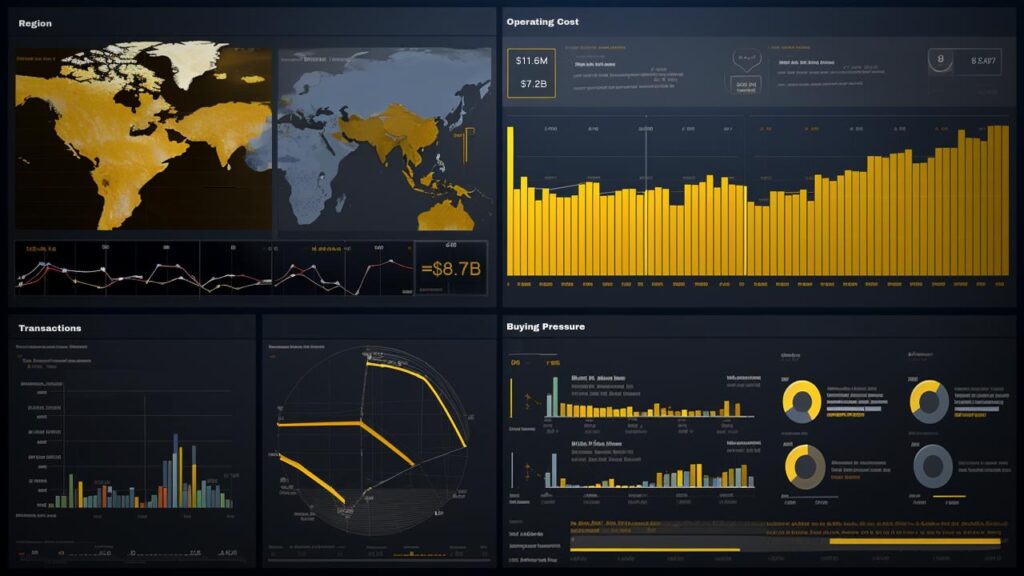Power BI is a comprehensive toolset provided by Microsoft that allows users to transform raw data from various sources into meaningful insights. It offers a range of software services, apps, and connectors to help users visualize, analyze, and share their data insights. Whether the data resides in an Excel spreadsheet, cloud-based databases, or hybrid data warehouses, Power BI can seamlessly connect, process, and present the data in an interactive manner.
Key Components of Power BI:
- Power BI Desktop: A Windows desktop application for creating detailed reports.
- Power BI Service: An online SaaS service for sharing and collaborating on reports and dashboards.
- Power BI Mobile: Apps available for Windows, iOS, and Android devices to access reports on the go.
- Power BI Report Builder: A tool for creating paginated reports that can be shared via the Power BI service.
- Power BI Report Server: An on-premises server for publishing and managing Power BI reports.
Usage Based on Roles: How one interacts with Power BI largely depends on their role within an organization. For instance, a business user might primarily use the Power BI service to view reports, while a data analyst might use Power BI Desktop extensively to create and publish reports. Sales professionals might rely on the Power BI Mobile app to track sales metrics, and developers can utilize Power BI APIs to integrate reports into custom applications.
Workflow in Power BI: A typical workflow starts with connecting to data sources using Power BI Desktop, followed by report creation. These reports are then published to the Power BI service, making them accessible to users on various platforms. Additionally, the Power BI service offers a deployment pipeline tool for testing content before it’s released to end-users.
Paginated Reports: Designed for printing or sharing, paginated reports are detailed reports that fit well on pages. They are ideal for operational reports or forms like invoices. Power BI Report Builder is the dedicated tool for creating such reports.
On-Premises Reporting with Power BI Report Server: For organizations that need to keep their reports on-premises, Power BI Report Server offers a solution. It allows users to create, deploy, and manage reports behind their firewall, ensuring data security.

How can businesses leverage Power BI to make more informed decisions?
Power BI, as a robust data visualization and business intelligence tool, offers a plethora of features that businesses can harness to drive data-driven decision-making. Here’s a deeper dive into how businesses can leverage Power BI:
- Unified Data View: Power BI can integrate data from various sources, be it spreadsheets, databases, cloud services, or even big data. This unified view ensures that businesses have a holistic understanding of their operations, enabling them to identify trends, anomalies, and opportunities.
- Interactive Dashboards: The tool allows users to create interactive dashboards that can be customized to show relevant metrics. Decision-makers can drill down into specific data points, allowing for a more granular understanding of the data.
- Real-time Analytics: Power BI supports real-time data processing. This means businesses can monitor their operations in real-time, making it easier to respond to emerging situations, be it a sudden spike in website traffic or a drop in sales.
- Predictive Analytics: With Power BI’s advanced analytics capabilities, businesses can forecast future trends. For instance, a retailer can predict sales for the upcoming holiday season based on historical data, helping them manage inventory better.
- Collaboration: Power BI is not just a tool for analysts. Reports and dashboards can be shared with team members, promoting a culture of data-driven decision-making across departments. Collaborative features also mean that teams can work together on reports, ensuring diverse perspectives are considered.
- Mobility: With Power BI Mobile, decision-makers are not tethered to their desks. They can access critical business reports and dashboards from anywhere, ensuring they’re always informed, even on the go.
- Customization and Extensibility: Every business is unique, and Power BI acknowledges this by allowing users to create custom visuals and integrate with other tools and platforms. This ensures that businesses can tailor Power BI to their specific needs.
- Security: Data security is paramount, and Power BI offers features like row-level security and data encryption to ensure that sensitive business data remains protected.
By leveraging Power BI, businesses can transform raw data into actionable insights. Whether it’s optimizing operations, identifying new market opportunities, or enhancing customer experiences, Power BI equips businesses with the tools they need to make informed, data-driven decisions.
In what scenarios would an organization prefer using Power BI Report Server over the cloud-based Power BI service?
Power BI Report Server is an on-premises solution for publishing, managing, and delivering Power BI reports, while the cloud-based Power BI service is hosted on Microsoft’s cloud infrastructure. The choice between the two often hinges on an organization’s specific needs, priorities, and constraints. Here’s a deeper exploration of scenarios where an organization might prefer Power BI Report Server:
- Data Security and Compliance: Some organizations, especially those in regulated industries like finance, healthcare, or government, have stringent data security and compliance requirements. They might need to ensure that their data never leaves their own infrastructure or country borders. In such cases, an on-premises solution like Power BI Report Server can offer greater control over data storage and access.
- Data Sovereignty: Data sovereignty laws dictate that data about a nation’s residents should be stored within that nation’s borders. Companies operating in countries with strict data sovereignty regulations might opt for on-premises solutions to ensure compliance.
- Network Latency Concerns: For organizations with significant amounts of data or those located in regions with limited internet bandwidth, transferring data to the cloud can introduce latency. An on-premises solution can provide faster data access and report rendering in such scenarios.
- Integration with Other On-Premises Systems: Companies that rely heavily on other on-premises systems might find it easier and more efficient to integrate with Power BI Report Server. This ensures seamless data flow between systems without the need for complex cloud integrations.
- Cost Considerations: While cloud solutions offer scalability, they come with recurring subscription costs. Some organizations might find it more cost-effective in the long run to invest in on-premises infrastructure, especially if they already have significant data center resources.
- Customization and Control: Power BI Report Server offers organizations the ability to customize their reporting environment to a greater extent than the cloud service. This can be crucial for businesses with specific reporting needs or those who want to maintain a consistent IT environment.
- Offline Access: In areas with unreliable internet connectivity or for organizations that need to access reports in offline environments (e.g., remote field operations), an on-premises solution ensures that reports are always accessible.
- Transitioning to the Cloud: Some organizations use Power BI Report Server as an interim solution while they prepare to transition to the cloud. It allows them to start benefiting from Power BI’s capabilities immediately, with the option to migrate to the cloud-based service when they’re ready.
While the cloud-based Power BI service offers scalability, flexibility, and reduced IT overhead, Power BI Report Server provides enhanced control, security, and integration capabilities. The choice between the two will depend on an organization’s specific context, needs, and strategic priorities.
How does the integration of various Power BI components streamline the data visualization and reporting process for diverse roles within an organization?
The integration of various Power BI components offers a cohesive ecosystem that caters to the distinct needs of different roles within an organization. This integrated approach ensures that from data sourcing to visualization and sharing, the entire process is seamless, efficient, and tailored to specific job functions. Here’s a deeper exploration:
- Data Engineers and IT Professionals:
- Data Integration: Power BI can connect to a wide array of data sources, from traditional databases to cloud platforms and even third-party services. This flexibility ensures that data engineers can integrate and transform data from diverse sources.
- Data Modeling: Power BI Desktop provides tools for data modeling, allowing IT professionals to define relationships, hierarchies, and calculated fields, ensuring the data is structured optimally for analysis.
- Data Analysts and Report Designers:
- Interactive Visualization: Power BI Desktop offers a drag-and-drop interface where analysts can create a variety of visualizations, from simple charts to complex multi-page reports.
- Advanced Analytics: With integration to tools like R and Python, analysts can run advanced statistical analyses and incorporate the results directly into their reports.
- Custom Visuals: If the built-in visuals aren’t sufficient, analysts can either import custom visuals created by others or design their own, ensuring reports are both informative and engaging.
- Business Users and Decision Makers:
- Power BI Service: This cloud-based platform allows business users to access shared reports and dashboards, drill down into data, and even create their own ad-hoc reports.
- Collaboration: Integrated collaboration tools mean that teams can comment on reports, share insights, and make collective decisions based on real-time data.
- Alerts and Subscriptions: Business users can set up alerts for specific data changes or thresholds, ensuring they’re always informed of critical business developments.
- Sales and Field Teams:
- Power BI Mobile: Sales and field teams are often on the move, and the Power BI mobile apps for iOS, Android, and Windows ensure they have access to critical data anytime, anywhere.
- Real-time Data: For roles that require up-to-the-minute information, such as sales or production monitoring, Power BI’s real-time data capabilities ensure they’re always looking at the latest data.
- Developers:
- Power BI APIs: Developers can integrate Power BI reports and dashboards into custom applications, ensuring that data visualization is consistent across the organization’s software ecosystem.
- Power BI Embedded: For software vendors or organizations building customer-facing applications, Power BI Embedded allows them to offer powerful data analytics features directly within their products.
- Administrators and Compliance Officers:
- Security: Role-based access, row-level security, and data encryption ensure that sensitive data is only accessible to authorized individuals.
- Audit and Compliance: Power BI’s audit log capabilities allow compliance officers to monitor and review data access and changes, ensuring adherence to regulatory requirements.
The integration of Power BI’s components creates a unified data analytics ecosystem where each role, from data engineers to business leaders, has tailored tools and capabilities. This ensures efficiency, collaboration, and a data-driven culture across the organization.








Leave A Comment